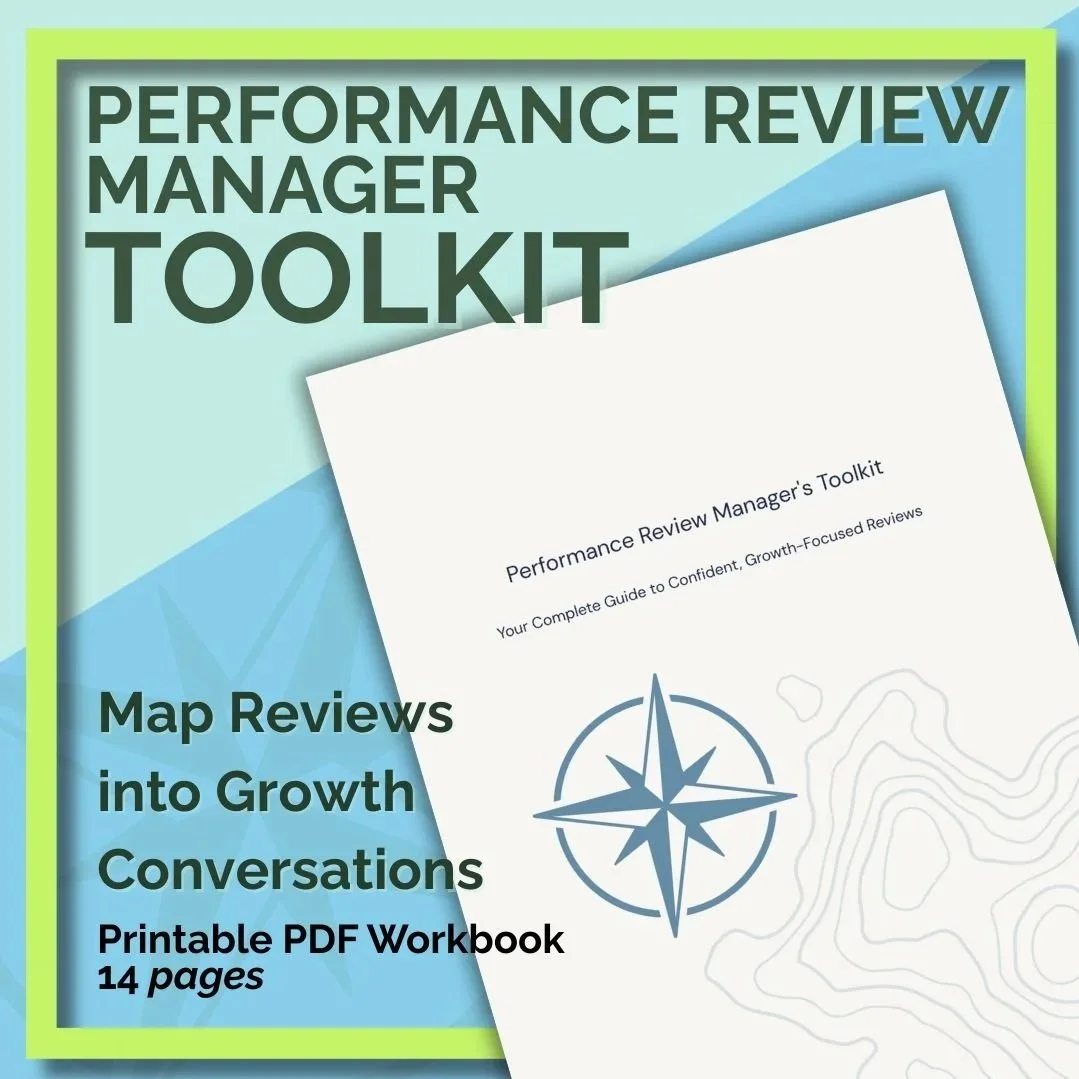The Performance Review Playbook: How to Build Trust and Drive Growth in 60 Minutes
Most performance reviews feel like judgment sessions. Here's how to transform them into development conversations that employees actually look forward to.
The calendar reminder appears: "Performance review with Sarah - Thursday, 3pm."
Your stomach tightens. Not because Sarah isn't performing well, but because you know how these conversations usually go. Stilted. Formal. Both of you counting the minutes until it's over.
But what if performance reviews could be different? What if they became conversations your team actually looked forward to—moments that built trust instead of anxiety, clarity instead of confusion?
The difference lies not in what you discuss, but in how you structure the conversation itself.
Why Most Performance Reviews Miss the Mark
Traditional performance reviews fail because they're built on a flawed foundation: the assumption that evaluation and development can happen simultaneously in a high-stakes conversation.
Here's what typically happens:
Managers spend 70% of the time looking backward
Employees sit passively while being "assessed"
The conversation feels more like a court proceeding than a partnership
Development planning gets rushed or skipped entirely
Both parties leave feeling disconnected
The result? A process that satisfies HR requirements but does nothing to strengthen relationships or drive growth.
Setting the Tone: The First 10 Minutes Matter Most
The opening moments of a performance review determine everything that follows. Your goal isn't to appear authoritative—it's to create psychological safety that enables honest conversation.
Start with Presence, Not Performance
Begin by acknowledging the person, not their work. This isn't small talk; it's relationship building.
Instead of: "Let's dive into your performance over the past quarter." Try this: "Before we get into the review, I want you to know how much I value having you on this team. This conversation is about supporting your success, not judging it."
Frame the Conversation as Partnership
Position yourself as an ally in their growth, not an evaluator of their worth.
Effective framing: "My role today is to understand how you're experiencing your work, celebrate what's going well, and figure out how I can better support your goals. This is a conversation, not a presentation."
Address the Elephant in the Room
Acknowledge that performance reviews can feel uncomfortable and normalize that feeling.
What to say: "I know these conversations can feel formal or stressful. If you need to pause at any point or want to revisit something, just let me know. We have plenty of time."
This transparency immediately reduces tension and creates space for authentic dialogue.
Creating Psychological Safety: The Foundation of Growth
Psychological safety isn't about being "nice"—it's about creating conditions where people can be honest about challenges, mistakes, and aspirations without fear of judgment or retaliation.
Use Curious, Not Conclusive Language
Replace statements with questions that invite exploration rather than defense.
Instead of: "Your communication needs improvement." Ask: "How do you feel your communication is landing with the team? What have you noticed?"
Validate Their Experience Before Offering Perspective
Acknowledge their reality before sharing your observations.
Example: "It sounds like the project timeline created a lot of pressure for you. I can see how that would be stressful. From my perspective, I also noticed that communication with stakeholders became less frequent during that period. What do you think contributed to that?"
Make Space for Disagreement
Invite them to push back on your observations or share different perspectives.
What to say: "That's my take on the situation. Does it align with how you experienced it? Where might I be missing something?"
This approach transforms potential conflicts into collaborative problem-solving.
Celebrating Accomplishments: More Than Just Praise
Most managers rush through accomplishments to get to "development areas." This misses a crucial opportunity to reinforce strengths and build confidence.
Be Specific About Impact
Connect their accomplishments to broader team and organizational success.
Instead of: "Great job on the Johnson project." Try: "The way you handled the scope change on the Johnson project kept us on timeline and actually strengthened our relationship with the client. That flexibility under pressure is something I really value in your leadership."
Ask Them to Reflect on Their Growth
Help them see their own development rather than just hearing about it from you.
Powerful questions:
"What are you most proud of from this quarter?"
"Where do you see the biggest growth in yourself?"
"What surprised you about your own capabilities?"
Connect Past Success to Future Potential
Use accomplishments as launching points for expanded responsibilities or new challenges.
Example: "Your success with the cross-functional project shows me you're ready for more complex stakeholder management. What kinds of challenges would you be excited to take on next?"
This approach builds momentum rather than just offering praise.
Future-Focused Development: The Heart of the Conversation
The most valuable part of any performance review is the forward-looking conversation. This is where development actually happens.
Lead with Their Aspirations
Start with where they want to go, not where you think they should improve.
Open-ended questions:
"What parts of your role energize you most?"
"Where do you want to be professionally in 18 months?"
"What skills or experiences would most excite you to develop?"
Co-create Development Goals
Rather than assigning areas for improvement, collaborate on growth opportunities that align with both their interests and business needs.
Collaborative approach: "Based on what you've shared about wanting to develop your strategic thinking, and my observation that you excel at tactical execution, what if we found ways for you to contribute to quarterly planning? How would that feel as a development focus?"
Make Development Concrete and Actionable
Vague development plans ("improve communication") help no one. Create specific, measurable steps.
Instead of: "Work on presenting skills." Be specific: "In the next quarter, you'll present the monthly team update twice, and I'll give you feedback after each one. We'll also identify a conference session or workshop on executive communication that you can attend."
Identify Support and Resources Needed
Don't just set goals—clarify how you'll support their achievement.
Essential question: "What do you need from me to be successful with these development goals? What obstacles should we anticipate?"
The Conversation Flow: A 60-Minute Structure
Here's a proven structure that creates psychological safety while driving meaningful development:
Opening (10 minutes)
Set the tone with warmth and partnership framing
Check in on how they're feeling about the conversation
Review the agenda and invite their additions
Accomplishments Review (20 minutes)
Ask them to share what they're most proud of
Offer specific, impact-focused recognition
Connect achievements to their growth and value to the team
Future Focus (25 minutes)
Explore their aspirations and interests
Discuss development opportunities and challenges
Co-create specific, actionable goals
Identify support and resources needed
Wrap-up (5 minutes)
Summarize key themes and commitments
Confirm next steps and timeline
Ask for feedback on the conversation itself
Essential Do's and Don'ts for Review Mechanics
✅ Do:
Come prepared but stay flexible: Have talking points but let their responses guide the conversation
Take notes: Shows you value their input and helps track commitments over time
Use their language: If they describe a challenge as "overwhelming," use that word in your response
Ask follow-up questions: "Tell me more about that" uncovers valuable insights
End with clear next steps: Both of you should know what happens after this conversation
❌ Don't:
Read from a script: Authentic conversation can't be scripted
Surprise them: No feedback should be completely new information
Make comparisons: Focus on their individual growth, not how they stack up to others
Dominate the talking: If you're speaking more than 40% of the time, adjust
Rush through accomplishments: Recognition builds the foundation for development conversations
When Reviews Go Off Track: Troubleshooting Common Challenges
"They seem defensive about feedback." Pause and check your approach: "I notice this feels uncomfortable. What would help this conversation feel more useful for you?"
"They don't seem engaged or invested." Ask directly: "How are you experiencing this conversation? What would make it more valuable for you?"
"The conversation feels too formal or stilted." Address it: "This feels more formal than our usual conversations. How can we make this feel more like the collaborative discussions we normally have?"
"They disagree with your assessment." Welcome it: "I'm hearing that your experience was different from mine. Help me understand your perspective on this."
Making Reviews Part of an Ongoing Conversation
The best performance reviews don't feel like isolated events because they're extensions of ongoing development conversations.
Monthly Check-ins
Brief conversations that prevent surprises and build continuous feedback loops.
Real-time Recognition
Acknowledging accomplishments when they happen, not just during formal reviews.
Development Conversations
Regular discussions about growth, challenges, and career aspirations separate from performance evaluation.
When these elements are in place, formal reviews become natural summaries of ongoing partnership rather than high-stakes evaluations.
Transform Your Performance Review Approach
Performance reviews don't have to be dreaded calendar events. With intentional structure focused on psychological safety, accomplishment celebration, and future development, they become powerful tools for building relationships and driving growth.
The mechanics matter: how you open the conversation, the questions you ask, the balance between past and future, the way you create space for dialogue rather than monologue.
When you get the mechanics right, performance reviews transform from compliance exercises into conversations that both you and your team members genuinely value.
Ready to discover your natural leadership style and get frameworks designed for how you actually lead? Take the free Leadership Pathway Explorer to understand your leadership identity and access personalized tools that fit your management approach.
Want ready-to-use performance review templates, conversation scripts, and development planning tools? The Manager's Map Drawer includes practical frameworks for reviews, one-on-ones, and team development conversations. Get your monthly management toolkit here.

